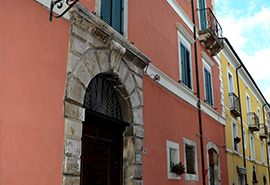The production of woolen cloth, ie. the transformation of wool into cloths, is an activity introduced in Palena around the eighteenth century: at the decline of sheep breeding and pasturing. It was in the valley of the River Aventine that an increase in the activity of wool processing purchased in Puglia and in the valley of Aquila, for the manufacture of cloth destinated for garment production. The presence of the river Aventine and the ability to harness the energy produced by its waters to wash and treat the wool constituted a fundamental requirement for the success and development of this factory that needed a particular industrial plant called "fulling".
In 1843, the Villa family probably from northern Italy came to Palena, they owned a mill with 15 workers. The data assessed and recorded in the Palena town hall shows that 100 pieces of cloth were produced that year. The family lived in this 'residential house' overlooking the main street of the village then called, via Matonata. Accessd through a large doorway to the sides of which there are two rooms used for warehousing, useful for the manufacturing activity of the Villas, but also used as a storage for timber and foodstuffs. The two upper floors were where the family lived. The noble floor, which overlooks the street through simple framed windows, presents an elegant porch on the back of the property formed by columns supporting a simple linear architrave.
The rise of the Villa family was certainly considerable if Alessandro Villa in 1909 was appointed chairman of the board of directors of the growing rural loans company created to support local farmers.

The production of woolen cloth, ie. the transformation of wool into cloths, is an activity introduced in Palena around the eighteenth century: at the decline of sheep breeding and pasturing. It was in the valley of the River Aventine that an increase in the activity of wool processing purchased in Puglia and in the valley of Aquila, for the manufacture of cloth destinated for garment production. The presence of the river Aventine and the ability to harness the energy produced by its waters to wash and treat the wool constituted a fundamental requirement for the success and development of this factory that needed a particular industrial plant called "fulling".
In 1843, the Villa family probably from northern Italy came to Palena, they owned a mill with 15 workers. The data assessed and recorded in the Palena town hall shows that 100 pieces of cloth were produced that year. The family lived in this 'residential house' overlooking the main street of the village then called, via Matonata. Accessd through a large doorway to the sides of which there are two rooms used for warehousing, useful for the manufacturing activity of the Villas, but also used as a storage for timber and foodstuffs. The two upper floors were where the family lived. The noble floor, which overlooks the street through simple framed windows, presents an elegant porch on the back of the property formed by columns supporting a simple linear architrave.
The rise of the Villa family was certainly considerable if Alessandro Villa in 1909 was appointed chairman of the board of directors of the growing rural loans company created to support local farmers.